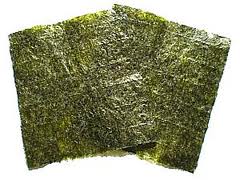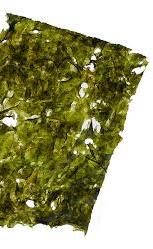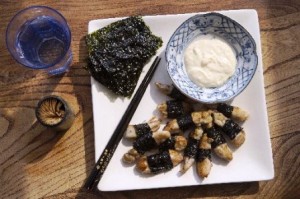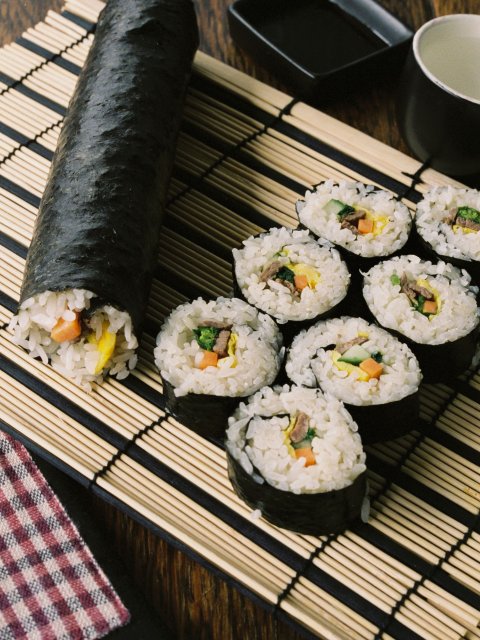A shorter version of this article was published in The Christchurch press and the Wellington Dominion Post on October 15th.
Nori is incredibly healthy. It contains vitamin A and C which help to keep our skin and immune system healthy and it is high in fibre. It has 10 times more calcium and iron by weight than dairy products and a greater proportion of vitamin C than oranges. It is believed to have an anti-inflammatory effect and to help relieve the pain of arthritis and osteoarthritis and it has a high content of trace minerals especially iodine which is important for thyroid function. It is particularly good for vegans as it contains vitamins B1, B2, B12 and it is great source of protein. Finally it is also rich in antioxidants which help to boost your immune system.

Nori is fantastic toasted and crumbled. Just use tongs to hold the sheets about 5cms above either your electric stove element or gas burner for a very short time (~1 minute), moving it around so that it toasts evenly. It will turn bright green and become crisp. Leave it to cool for a few moments and then crumble it up. Sprinkle this over any type of salad, over seafood dishes or on noodles. You can also mix it into batter before dipping vegetables or seafood in it for frying. Try adding it to stir-frys or use it as a garnish on soups. We have used it as part of a stuffing mixture for both fish and chicken. When I lived in Japan and Korean, my favourite, simple breakfast was a bowl of rice topped with a fried egg and a dob of Gochuchang* chilli paste (if going Korean), or natto (Japanese fermented soy-beans) that you mix around with the rice. You then pop forkfuls of the rice into a strip of nori, wrap it up and eat it.
If you want to try something different with your sushi, try making it the Korean way. Japanese sushi is characterized by ‘sweet and sour” flavours that are created by mixing sugar and rice vinegar into the cooked rice. The Korean version, Gimbap, substitutes sesame oil and salt in the cooked rice in place of the sugar and vinegar. Mix them into the rice and make your sushi in the normal way. I much prefer this version and it is especially good with smoked salmon and avocado filling. Korean nori – ‘gim’ – also has a lovely salty/sesame flavour. If you can get it, try it instead of the Japanese version.

*Pantry Note: Gochuchang is a Korean spicy chilli paste used as a condiment or cooking ingredient. You can buy it at good supermarkets or Asian specialty stores.
The following recipe using nori is one that I serve a lot when catering for Ground. We serve it as a canapé finger food and it is usually incredibly popular. None ever went back into the kitchen, much to the disappointment of the staff.

Nori-wrapped Chicken with Ginger Mayo
Serves 8 as finger food. First make the dipping sauce. We use Japanese QP mayonnaise because it has that amazing umami flavour and, unlike most commercial western mayonnaises, has no added sugar in it.
Ginger Mayo;
½ a cup QP mayonnaise
2 cm piece of ginger, grated (use a microplane if you have one)
juice of ½ a lemon
Combine all the dip ingredients and set aside – this allows the flavours to develop while you cook the chicken.
Ingredients
300gs of skinless, boneless chicken breast
2 cm piece of ginger, grated
½ teaspoon salt
½ teaspoon pepper
2 cloves crushed garlic
a pinch of chilli powder
4 sheets of nori cut into 1½ cm wide strips
Cut the chicken into thick thumb size strips. They should be 5-7 cm in length. Place them in a bowl and marinate for at least 20 minutes with the ginger, salt, pepper, garlic and chilli.
When ready to cook, heat a large non-stick frying pan to a medium heat and add a couple of teaspoons of oil. Take a piece of chicken and wrap a strip of nori around the middle of the chicken. Stick it together with a dab of water. Repeat with each piece of chicken. Panfry the chicken (it should be well sealed with a little colour and the nori will become slightly crispy) - it is important to turn them often to ensure even colour and cooking. Serve hot with the ginger mayo.
Poached fish in Nori Butter Sauce
Serves 4
4 good-sized fillets of fish
750 ml fish stock
300g unsalted butter
1 shallot, finely chopped
1 bay leaf
2 whole peppercorns
50 ml white wine
25 ml white wine vinegar
4 tablespoons of cream
2 sheets nori, finely chopped
Season the fish fillets with salt and freshly ground black pepper. Pour the fish stock into a large frying pan. Bring to the boil then reduce to a simmer. Put the fish in the gently simmering stock and cook for 4-6 minutes. When cooked, drain the fillets (reserving a tablespoon of the cooking liquor) and set aside until you are ready to serve.
To make the butter sauce, place a frying pan over a medium heat. Add 150g of the butter and the chopped shallot, bay leaf and peppercorns. Cook for 2-3 minutes, then add the white wine, white wine vinegar and a tablespoon of the cooking liquor from the fish. Simmer until the liquid has reduced by three-quarters. Stir in the cream, then slowly incorporate the remaining butter. The sauce should be thick enough to coat the fish fillets. Season to taste with salt and freshly ground black pepper. Plate up the fish and just before serving add the nori to the butter sauce. Pour over the fish.

